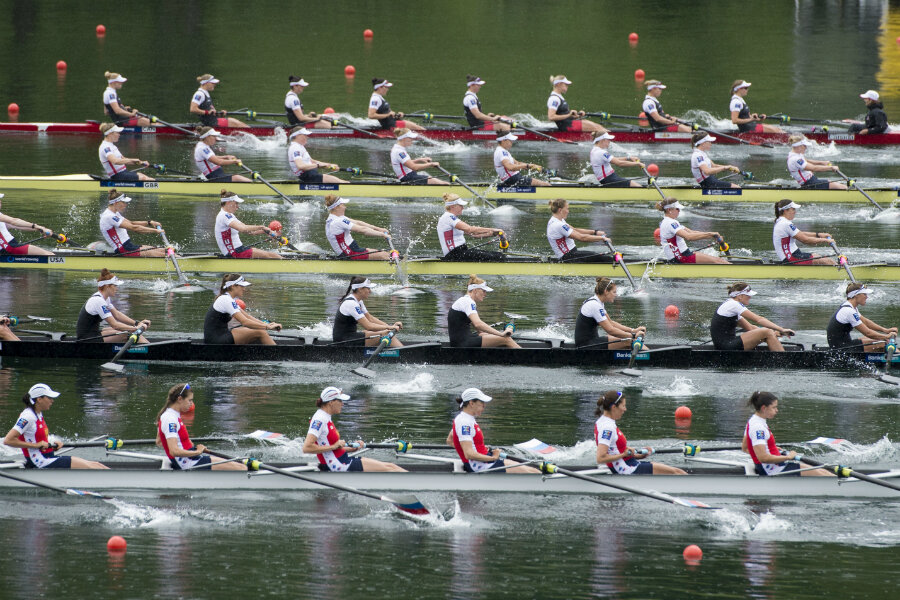On her shoulders: record number of female Olympians expected in Rio
Loading...
When the final landings were stuck and the finish lines were crossed in the London 2012 Summer Olympic Games, American athletes had won more medals than those of any other country.
And the majority of those medals, gold and otherwise, were won by women.
The 2012 Games marked the first time that the US team had sent more women than men to the Olympics. When the international competition kicks off this week in Rio de Janeiro, that ante will be upped again as the United States sends 292 female athletes, the largest women’s team ever fielded by any country in the Games.
The groundbreaking US team may be part a broader distinction for these Olympics, which the International Olympic Committee hopes will have the highest proportion of female participants ever fielded, beating out London where 44 percent of the competitors were female. That uptick in women competitors is part of a larger landscape of evolving gender equality in the Games, which remain one of the few platforms where female athletes get to see their names in lights.
The Olympics has come a long way when it comes to embracing female athletes. A grand total of zero female athletes competed at the first modern Games in 1896 (founder Pierre de Coubertin reportedly thought female participation would be "impractical, uninteresting, unaesthetic, and incorrect.") In the following Games of 1900, 22 of the nearly 1,000 athletes were women. They competed in tennis, sailing, croquet, equestrianism, and golf. Two women took home gold medals, one for a mixed-gender sailing team (Switzerland) and the other for singles tennis (Britain).
In 1928, track and field was added for women, but after controversial reports depicted several of the women passing out after the 800-meter event the Olympic committee banned women from running anything longer than 200 meters. That ban would last until 1960, while the marathon would not be added until 1984. Then in 1991 the International Olympic Committee decided that all new sports wishing to be included on the program must feature both men's and women's events.
However the 2012 London Games were the first where women competed in every single sport in the competition. This was not the same for men, who do not have an option for synchronized swimming or rhythmic gymnastics. Those games were also the first where every nation was represented by at least one female athlete (a first for Saudi Arabia, Qatar, and Brunei); this year Saudi Arabia will bring two women, while Qatar and Brunei will remain represented by one each.
The 292 women who will represent the US in the 2016 Games stands in contrast to those countries, and American fans are looking to see the female teams continue to dominate in events where they hold serious winning streaks.
Basketball is one such sport: Team USA team has won 41 consecutive Olympic tournament games and is pursuing a sixth consecutive gold medal. Women’s soccer is another. The US team is both the defending Olympic gold medalist and FIFA World Cup champion. The women’s rowing eight team has not lost an Olympic or world championship title in a decade; and the US women’s artistic and diverse gymnastics team has won every world and Olympic title since 2011.
Individual stars are also drawing buzz, such as Katie Ledecky, who has the 11 fastest performances in the 800 meter freestyle, outstripping the famous Michael Phelps in records, according to The Wall Street Journal.
"We mass-produce athletes," Donna Lopiano, an expert on women's athletics and gender equality told the Journal Sentinel. "When you think about it, we have probably the largest mass of women in the world playing sports."
Ms. Lopiano believes that the prominence of the female American athlete is related to the linkage between sports and educational institutions, which must follow Title IX regulations for equality between genders in all aspects of education, including athletics.
While attention given to women's sports in mainstream American culture is subsumed by coverage of men's sports, the Olympics has become a platform where women athletes can find national and international spotlight, said Cheryl Cooky, president of the North American Society for the Sociology of Sport, in an interview with the Journal Sentinel.
"The Olympics show us that women aren't just on the sidelines, but can be the stars of the show."
Material from the Thomson Reuters Foundation was used in this report.







